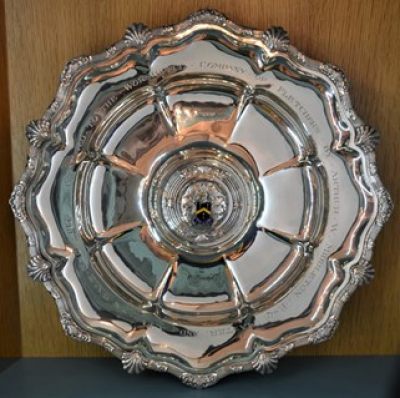The Rose Bowl was donated by Arthur Middleton Esq. Master of the Worshipful Company of Fletchers (1938-39).
The custom of the Rose Bowl has been practised since at least Tudor times when the silver bowls demonstrated the host’s wealth, and the scented water they contained was used to rinse guests’ hands before, during and after banquets – all too necessary when forks did not exist and guests were expected to bring their own knives to cut their food.
Today the purpose of the Rose Bowl at dinner is to aid digestion and to refresh you. When the Bowl is placed before you, dip the corner of your napkin into the rose water, gently shake off any excess and place the wet cloth immediately behind each ear, leaving it there long enough for you to feel its cooling effect. Then wipe the wet cloth across the front of each of your wrists.
The effect of these acts will be twofold. Placing the cool wet cloth behind each ear will stimulate the nerve that supplies the skin at this site. This nerve, known as the “Alderman’s nerve”, is anatomically linked to the vagus nerve that supplies the heart and the stomach. Stimulation of the vagal fibres to the heart gently slows the heartbeat and, at the stomach, leads to an increased release of gastric juices; this increased gastric motility speeds emptying of the stomach. The effect of both will aid your general comfort after dinner and improve digestion leaving you better able to appreciate the speeches. Wiping the wet cloth over the warm skin behind the ears and across the wrists also has a cooling effect as the water evaporates. This cooling sensation is transferred to the underlying blood vessels providing an overall effect that is refreshing – a sensation that is familiar to ladies when they dab perfume on the same areas.

